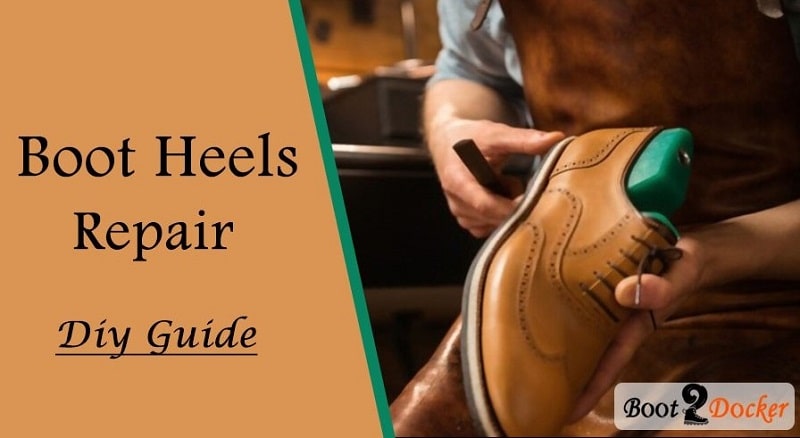Boot Heels Repair: Diy Guide
by James Miller
Every time you walk on the road, the boot’s heel is the part that is most likely to wear out due to its rubbing against the rough surface. Additionally, a significant portion of body weight is exerted on the heels, so they deteriorate faster than any other boot area.
Boots that have been used for an extended period have cracked or worn-out heels. In this article, you will get in-depth information on how to repair the worn-out heels of your boots.
Ways of boot heel repair
Here are some of the ways you can use to repair your boot’s heels through a DIY approach.

Replacement of the worn-out heel with a new one
If you realize that your boot’s heel is worn out, you can replace it through the following steps.
Step #1: Removal of the worn-out heel
Use pliers to remove the nails that attach the heel to the boot. After that, pull the heel backward to remove it.
Step #2: Make the surface smooth
Using sandpaper, smoothen the boot’s rough surface where the worn-out heel was fixed.
Step #3: Build the heel backup
Utilizing adhesive, paste the skived portion of leather on the heel region where the boot is worn out. Next, use smoothening paper to level the leather surface.
Step #4: Add a new heel
Place the new heel above the boot’s leather piece. After that, hammer the nails into the boot to attach the heel to the boot.
Step #5: Final touches
Use sandpaper to level the heel and parts near it. Next, color the new heel with appropriate boot polish.
Fixing a damaged top lifts of a heel block
Here are the steps for fixing damaged top lifts of a heel block.
Step1: Pulling off the top lifts
Using pliers, take off the top lifts of sole of your boots.
Step 2: Smoothen the surface with sandpaper.
Leveling the surface with sandpaper ensures that it is clean and ready to fit the new lifts.
Step 3: Stick the new top lifts
Put contact glue on the new top lifts and the heel and let it stay there for about 15 minutes. After that, paste the top lifts on the heel.
Step 4: Finishing up
Use sandpaper to smoothen the sides of the heel so that it matches the top lifts. Use your favorite shoe polish to give your shoes the final touches.
Fixing a new sole that is loose or coming out of the heel
If the sole of your boot is loose or coming out of the heel, follow these steps to fix it.
Using pliers, pull the sole of the boot backward.
Apply contact glue on the sole and the heel of the boots and let them dry for about 15 minutes. After that, press the sole firmly onto the heel and hold for around two minutes.
Using cobbler’s nails, hammer them into the sole to attach it to the heel
Fixing a hole at the bottom of the sole or heel
If you want to fix a hole at the bottom of a sole or heel, utilize sole adhesive for the exercise. Fill in the holes with some adhesive and allow it to dry for about 15 minutes. After that, level the surface with sandpaper to make it more appealing.
Fixing worn-out or damaged heel tips
If your boot heel tips are damaged, you can fix that by replacing them. Use the following steps to replace them.
Get a set of new boot heel tips that match the damaged ones. Before you buy the new ones, measure the width and height of the existing heel tips. Additionally, ensure that the new heel tips’ color matches the one on your boots.
Using a pair of pliers, pull the heel tips backward. To avoid damaging the boots’ heels, gently rotate the tip out of place.
Using a metal dowel, push the end of a replacement heel tip to the hole on the heel. Align the tip’s shape to the heel so that it is easy to make future adjustments.
Setting the shoe on a solid surface, carefully push the tip while taking precautions to prevent the breakage of the heel.
Using a hammer, tap the bottom of the heel top to move it further. Ensure that the two parts fit together.
Use pliers to grip and turn the side of the tip till it lines up with the heel.
Fixing broken heels
If the heels on your boot break suddenly, don’t worry; here are some DIY tips to help you.
- Reinsert the heels
Reinserting the heel back into the slot of the boot’s hole is the quickest method you can use to fix your broken heels. Before you do the insertion, examine the broken heel and ascertain if it is viable to insert it. Assess the nails’ alignment and reinsert the heel without using a lot of force.
- Reattaching with glue
Using glue is the fastest and most convenient way of fixing broken heels. To achieve excellent results, consider using super or wood glue to do the reattachment.
Here are the steps to follow.
Wipe off the old glue and any dirt from the heel and boots. This will prepare the surface for the adhesive to stick.
Apply an ideal amount of glue to make the heel hold firmly without interfering with the boot’s balance. More importantly, ensure that the heel is well aligned.
After applying the glue, allow the heel to dry. If you want to strengthen it, consider drying it at night.
- Replacing the sole
Replacement is inevitable when the boot soles are thin. It is crucial to measure the width, thickness, and length of the replacement to ensure that it fits the old one. If you fail to get a replacement that matches the size of your boot, it advisable to buy the largest one and then trim excess edges.
Here are the steps for replacing the sole.
Using pliers, pull the sole and heel out of the shoes. Use sandpaper to remove excess glue and level the surface.
Apply contact glue to the bottom of the boots and sole, and allow it to dry for about ten minutes.
Once the glue is dry, line up the heel with the bottom of the boot. Apply some pressure for about 30 seconds to allow a strong connection between the two parts.
To ensure that the heel and the sole are lined up, use a utility knife to trim the heel around the bottom.
How to protect your boot’s heels
Here are some of the ways you can use to protect your boot’s heels.
- Utilize a protectant spray
A protectant spray will keep your shoes clean and protect them against water damage.
- Utilize heel guards
In case you realize that your stilettos are getting scrapped, wrap a protector around the heel to avert any damage that may arise. Ensure to match a shiny finish with your shoes to make the guards invisible.
- Use heel caps
Adding heel caps will protect your shoes from sinking into mud and getting dirty. Likewise, you may replace your existing caps in case they are worn out.
- Consider sole guards
If you want your current boot’s sole no to wear out soon, consider adding sole guards to the shoes. Sole guards come in two forms – the temporary and long-lasting ones. If you are in a hurry, you can use the stick-on ones, though they don’t last long.
- Condition your leather
Prolonged exposure of your shoes to the moisture or sun can reduce their lifespan. To enhance their suppleness and prevent their color from fading, it is advisable, condition them with appropriate creams.
Top tips for maintaining your boots
Here are the tips that can make your boots last longer
- Protect them against adverse weather elements
Always spray your boots with protective sprays that act as repellants against winter weather or spills. It is advisable to spray your boots once a week if you want to make them more protective.
- Moisturize your leather
Moisturizing your leather will make them shine and last longer.
- Add a protective rubber sole to your shoes.
If you want to protect your shoes during winter, it is advisable to add a protective rubber sole to the existing one.
- Watch your heels
Keep an eye on your heels, and if they are worn out, don’t hesitate to replace them. Immediate replacement will help you avoid incurring expensive costs in the long run.
- Wipe down boots after every wear
After wearing your shoes, it is vital to wipe them with a dust bag to remove any accumulated dirt.
- Utilize leather cream to treat scuffs or fading colors
If you want to treat discoloration in your boots, use a small brush to apply leather cream to the affected surface. In case there is extreme fading, consider taking your shoes to a cobbler for proper fixing.
- Repair salt or stain immediately.
If you have been out in the snow or salty streets, use a salt stain remover if your boots have such stains. Ensure to apply the remover immediately and let the boots air dry overnight until the stains are fixed.
 |
 |
 |
 |

About James Miller
James Miller is a dedicated individual based in the vibrant city of San Francisco, CA, USA. His unwavering passion lies in the realm of construction, where he finds fulfillment in exploring and documenting various facets of construction equipment and processes. A graduate of the University of California Merced, James holds a dual degree in mechanical and electrical engineering, which has equipped him with a solid foundation in technical knowledge.
With a keen eye for detail and a knack for articulation, James has channeled his enthusiasm into writing about the intricacies of construction gear and methodologies. His insightful writings offer valuable insights to both industry professionals and curious enthusiasts, shedding light on the machinery and techniques that shape the built environment.
James Miller's educational background in mechanical and electrical engineering lends credibility to his work, allowing him to delve into the technical nuances of construction with precision. His passion for sharing knowledge and fostering understanding in the construction field is evident in his contributions, making him a respected voice in the industry.
Thoughts on "Boot Heels Repair: Diy Guide"
 |
 |
 |
 |
Get FREE Boots Gifts now. Or latest free toolsets from our best collections.
Disable Ad block to get all the secrets. Once done, hit any button below
 |
 |
 |
 |